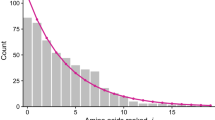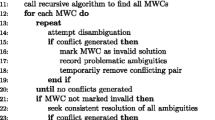Summary
The mRNA sequences of beta hemoglobin for human, mouse and rabbit were examined. Observations included the following: (1) there is a significant bias against the use of codons only one nucleotide different from terminating codons; (2) less than 4% of the codons end in adenine; (3), guanine is the most common third position nucleotide but it never follows a second position cytosine; (4) nearest neighbor (doublet) nucleotides are non-random with the greatest contributor to non-randomness being the third position suggesting that codon choice for a given amino acid rather than a choice among amino acids is the more important contributor; (5) the CG dinucleotide is even rarer in positions other than the first and second of the codon than it is in those two, suggesting that the need for arginine has in fact elevated the CG frequency in those positions; (6) 77 per cent of the nucleotides are unsubstituted among these three taxa, which could be a sampling effect, but there is strong evidence that about one-third of them are in fact unsubstitutable because of selective constrainsts; (7) the two longest stretches of unsubstituted nucleotides (32 and 35 consecutive nucleotides) surround the points of the two non-coding insertion sequences; (8) over half the substitutions occur in the third nucleotide position of the codons; (9) silent (non-amino acid changing) substitutions occur at about four times the rate of non-silent substitutions on the basis of their relative opportunity to occur; (10) silent substitutions occur slightly but significantly more often in codons that also have non-silent substitutions than independence of the two events would predict; (11) substitutions occur in adjacent nucleotides significantly more often than chance would predict; (12) among four-fold degenerate codons, third position transitions (principally cytosine-uracil interchanges) outnumber transversions by two to one although the reverse ratio would be expected.
The analysis of these messengers provided an opportunity to evaluate the random evolutionary hit (REH) theory. I observed that: (1) the REH theory is premised upon five assumptions, all false; (2) the theory leads to contradictory estimates of the number of varions; (3) the REH values are underestimates; (4) the REH values frequently violate the triangle inequality; (5) the REH values, contrary to claim, are not concordant either with accepted point mutations (PAMs) or augmented distances; (6) the REH values are more likely than values uncorrected for multiple substitutions to give incorrect phylogenies; and (7) the REH values have statistical problems probably associated with a large variance in its fundamental parameter, re. From this I conclude that REH theory is not suitable for its intended purpose of estimating from protein sequences of nucleotide substitutions since the common ancestor of two gene products.
Similar content being viewed by others
References
Cavalli-Sforza LL, Edwards AWF (1967) Amer J Hum Gen 19:233–257
Czelusniak J, Goodman M, Moore GW (1978) J Mol Evol 11:75–85
Dayhoff MO (1972) Atlas of protein sequence and structure, vol 5
Derancourt J, Lebor AS, Zuckerkandl E (1967) Bull Soc Chim Biol 49:577–607
Dobson AJ (1974) J Appl Prob 11:32–42
Eck RV, Dayhoff MO (1966) Atlas of protein sequence and structure, vol 1
Efstratiadis A, Kafatos FC, Maniatis T (1977) Cell 10:571–585
Fitch WM (1971a) Biochem Gen 5:231–241
Fitch WM (1971b) Syst Zool 20:406–416
Fitch WM (1972a) Haematol Bluttransfus 10:199–215
Fitch WM (1972b) Brookhaven Symp Biol 23:186–216
Fitch WM (1973a) Annu Rev Genet 7:343–380
Fitch WM (1973b) J Mol Evol 2:181–186
Fitch WM (1973c) J Mol Evol 2:123–136
Fitch WM (1976a) J Mol Evol 8:13–40
Fitch WM (1976b) In: Ayala FJ (ed) Molecular study of biological evolution. Sinauer, Sunderland, MA, p 160
Fitch WM (1976c) Science 194:1173–1174
Fitch WM, Farris JS (1974) J Mol Evol 3:263–278
Fitch WM, Langley CH (1976a) Fed Proc 35:2092–2097
Fitch WM, Langley CH (1976b) In: Goodman M, Tashian, RE (eds) Progress in molecular anthropology. Plenum Press, New York, p 197
Fitch WM, Margoliash E (1967) Biochem Genet 1:65–71
Fitch WM, Markowitz E (1970) Biochem Genet 4:579–593
Forget BG (1977) Hemoglobin 1:879–881
Godson GN, Barrell BG, Staden R, Fiddes JC (1978) Nature 000:236–247
Goodman M (1976) In: Goodman M, Tashian RE (eds) Progress in molecular anthropology. Plenum Press, New York, p 321
Goodman M, Moore GW (1977) J Mol Evol 10:7–47
Goodman M, Moore GW, Barnabas J, Matsuda G (1974) J Mol Evol 3:1–48
Holmquist R (1972a) J Mol Evol 1:115–133
Holmquist R (1972b) J Mol Evol 1:134–149
Holmquist R (1972c) J Mol Evol 1:211–222
Holmquist R (1976a) In: Goodman M, Tashian RE (eds) Progress in molecular anthropology. Plenum Press, New York, p 89
Holmquist R (1976b) J Mol Evol 8:337–349
Holmquist R (1978a) J Mol Evol 11:361–374
Holmquist R (1978b) J Mol Evol 12:17–24
Holmquist R, Jukes TH (1972) J Mol Evol 2:10–16
Holmquist P, Pearl D (1980) J Mol Evol 16:
Holmquist R, Cantor CR, Jukes TH (1972) J Mol Biol 64:145–162
Holmquist R, Jukes TH, Moise H, Goodman M, Moore GW (1976) J Mol Biol 105:39–74
Jukes TH (1978a) J Mol Evol 11:121–127
Jukes TH (1978b) J Mol Evol 11:267–269
Jukes TH, Holmquist R (1972) J Mol Biol 64:163–179
Kafatos FC, Efstratiadis A, Forget R, Weissman SM (1977) Proc Nat Acad Sci USA 12:5618–5622
Kimura M (1968) Nature 217:624–626
Kimura M (1979) Proc Nat Acad Sci USA 76:3440–3444
Kimura M, Ohta T (1972) J Mol Evol 2:87–90
King JL, Jukes TH (1969) Science 164:788–798
Konkel DA, Tilghman SM, Leder P (1978) Cell 15:1125–1132
Margoliash E, Fitch WM (1968) N Y Acad Sci 151:359–381
Margoliash E, Smith E (1965) In: Bryson V, Vogel H (eds) Evolving genes and proteins, Academic Press, New York, p 221
Marotta CA, Wilson JT, Forget BG, Weissman SM (1977) J Biol Chem 252:5040–5053
Moore GW, Barnabas J, Goodman M (1973) J Theor Biol 38:459–485
Moore GW, Goodman M, Callahan C, Holmquist R, Moise H (1976) J Mol Biol 105:15–37
Nei M, Tateno Y (1978) J Mol Evol 11:333–347
Ohta T, Kimura M (1971) J Mol Evol 1:18–25
Seeburg PH, Shine J, Martial JA, Baxter JD, Goodman HM (1977) Nature 270:486–499
Smith M, Leung DW, Gillam S, Ashell CR, Montgomery DL, Hall BD (1979) Cell 16:753–762
Subak-Sharpe H, Burk RR, Crawford LV, Morrison JM, Hay J, Keir HM (1966) Cold Spring Harbor Symp Quant Biol 31:737–748
Swartz MN, Trautner T, Kornberg A (1962) J Biol Chem 237:1961–1967
Tateno Y, Nei M (1978) J Mol Evol 11:67–73
Ulrich A, Shine J, Chirgwin J, Pictet R, Tischer E, Rutter WJ, Goodman HM (1977) Science 196:1313–1319
Vogel F (1972) J Mol Evol 1:334–367
Vogel F, Kopun M (1977) J Mol Evol 9:159–180
Waterman MS, Smith TF, Singh M, Beyer WA (1977) J Theor Biol 64:199–213
Zuckerkandl E, Pauling L (1965) In: Bryson V, Vogel HJ (eds) Evolving genes and proteins. Academic Press, New York, p 97
Zuckerkandl E, Derancourt J, Vogel H (1971) J Mol Evol 59:473–490
Author information
Authors and Affiliations
Rights and permissions
About this article
Cite this article
Fitch, W.M. Estimating the total number of nucleotide substitutions since the common ancestor of a pair of homologous genes: Comparison of several methods and three beta hemoglobin messenger RNA's. J Mol Evol 16, 153–209 (1980). https://doi.org/10.1007/BF01804976
Received:
Revised:
Issue Date:
DOI: https://doi.org/10.1007/BF01804976




